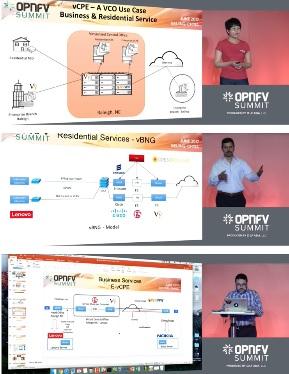In mid-June, I had the great pleasure to share the stage during the keynote at OPNFV Summit held in Beijing with OPNFV director Heather Kirksey, Lingli Deng, a project manager with China Mobile, NEC engineer Carlos Gonçalves, and Azhar Sayeed, chief architect for the service provider/telco group at Red Hat. On this event, we showcased how the Virtual Central Office (VCO) project could deliver residential and business services.
 I still remember, it was the middle of May during the OpenStack Summit in Boston, we sat around a table with the VCO project community members, to discuss the setup of a virtualized central office in a lab and the possibility of demonstrating a functional prototype working live on stage at the OPNFV Summit. I have to admit it was a real challenge to set up such an enterprise in three weeks, and honestly, this would not have been possible without the incredible effort and commitment from OPNFV community partners such as Cisco, Cumulus, Ericsson, F5, Intel, Lenovo, Mellanox, NetScout, Nokia, the Linux Foundation and the passion of the remarkable team assembled for the task.
I still remember, it was the middle of May during the OpenStack Summit in Boston, we sat around a table with the VCO project community members, to discuss the setup of a virtualized central office in a lab and the possibility of demonstrating a functional prototype working live on stage at the OPNFV Summit. I have to admit it was a real challenge to set up such an enterprise in three weeks, and honestly, this would not have been possible without the incredible effort and commitment from OPNFV community partners such as Cisco, Cumulus, Ericsson, F5, Intel, Lenovo, Mellanox, NetScout, Nokia, the Linux Foundation and the passion of the remarkable team assembled for the task.
 After working around the clock for three weeks, I couldn't hide the joy of seeing the local branch CPE on stage connecting live to the virtualized central office located halfway around the world in Lenovo’s lab in Raleigh, North Carolina. We successfully demonstrated an end-to-end business service providing local breakout traffic to the internet and a remote VPN connectivity to the virtual router in the central office!
After working around the clock for three weeks, I couldn't hide the joy of seeing the local branch CPE on stage connecting live to the virtualized central office located halfway around the world in Lenovo’s lab in Raleigh, North Carolina. We successfully demonstrated an end-to-end business service providing local breakout traffic to the internet and a remote VPN connectivity to the virtual router in the central office!
As the last physical interface with the end customer for service delivery, the central office plays a critical role for communication service providers (CSPs), as it is where the network subscriber’s connectivity is terminated. It used to be the copper termination point before becoming the home for mobile gateways, Radio Access Network (RAN) and fiber optic termination (FTTx). In the future, the central office will be the foyer for access-agnostic applications and services considering the evolution of Multi-access Edge Computing (MEC) technologies.
Previous attempts to virtualize the central office have resulted in proprietary or limited approaches by building components from scratch to address specific issues. With the latest developments in orchestration tools and newest features in OpenDaylight SDN controller, in-built capabilities for a virtualized central office are now available.

The VCO project aims to build an “OpenDaylight-based reference architecture” which could be combined with other projects (such as OpenStack for NFV) to create solutions that support the delivery of residential, business and mobile services.
The relevance of the VCO architecture is weighted by the need of delivering services as close as possible to the customers by leveraging computing capabilities at the edge. In this new era of networks programmability and software-defined infrastructure, the redesign of central offices has become a key competitive advantage for CSPs on their digital transformation journey, an unexpected value from longtime acquired assets.
关于作者
Hanen Garcia is Global Telco Solutions Manager at Red Hat, with more than 20 years of experience in the telecommunications industry building network solutions and value-added services for large telecom operators. In his current role, he is driving solutions to support telecommunications service providers during their network transformation journey. Prior to joining Red Hat, he worked at Ericsson as an innovation specialist designing cutting-edge solutions for mobile networks. Garcia holds an M. Eng. in innovation management from the ÉTS in Canada and an M.Eng. in telecommunications from Polytech in France.
产品
工具
试用购买与出售
沟通
关于红帽
我们是世界领先的企业开源解决方案供应商,提供包括 Linux、云、容器和 Kubernetes。我们致力于提供经过安全强化的解决方案,从核心数据中心到网络边缘,让企业能够更轻松地跨平台和环境运营。

